Concerning eco-friendly, economical, and sustainable properties, waste recycling has always been a current topic for the research community regarding construction materials[1-5]. Waste glass is a typical solid waste, which causes environment pollution and land occupation. How to reuse a large amount of waste glass is an urgent problem to be solved, which is of great practical significance. In the last decades, much research has been reported on recycling waste glass as noncontainers, including building materials (glass tiles and bricks, panels, etc.), road construction materials, glass fibers, etc[6-9]. The feasibility of recycling waste glass for cement materials has been explored by various preceding studies. Meanwhile, since road materials are an important part of construction materials, road materials containing partial waste glass have also been explored in recent years[10-12].
There is much research on the application of waste glass to cement concrete. Gupta et al.[13] developed a novel cement mortar with fire resistance and high mechanical strength, which can be used in construction. They used waste glass with different additions to replace part of the fine aggregates, and the result proved that 25% addition has the best performance and the compressive strength was higher than the target average, but the compressive strength of normal M40 grade concrete decreased. Lu et al.[14] developed an alkali-based cement mortar, which contained waste glass, and indicated that the use of glass powder and cullet can improve workability and high temperature stability. Due to the poor cohesiveness between glass and asphalt, the research on asphalt mixtures is not as popular as in the cement concrete field. Arabani et al.[15] explored the hot mix asphalt mixtures containing waste glass powder, waste brick powder, rice husk ash, and stone dust, and the results indicated that waste glass powder and waste brick powder mixtures are better than other mixtures for fatigue performance. Sanij et al.[16] used 10% cullet as aggregates with the maximum size of 4.75 mm in warm mix asphalt mixtures and zycothermTM as anti-stripping agent. The result proved that zycothermTM can improve the adhesion between the asphalt binder and glass aggregates. Much research indicates that the potential of waste glass application to road construction is significant.
To verify the feasibility of glasphalt mixtures, in this study, the waste glass is used as aggregates to replace partial mineral aggregates in asphalt mixtures, and the Marshall test, splitting strength test, freeze-thaw splitting test and skid resistance test are conducted to determine the optimum content of glass aggregates and asphalt, and the technical performance of this novel glasphalt mixtures is explored. Compared to the existing literature, the weak cohesiveness between glass and asphalt binder is considered by surface treatment with nano-Fe2O3 suspension in the experiment.
1 Preparation of Glass Aggregates and Surface Treatment
1.1 Preparation of glass aggregates
In this study, the self-developed glass crusher was modified by the general Marshall compactor to crush the waste glass to cullet, which is shown in Fig.1[17]. After crushing, the cullet is washed and dried for the subsequent application as shown in Fig.2. Finally, the cullet is sieved by the automatic shaking sieve machine. The glass aggregates of 2.36 and 4.75 mm are adopted. As the thickness of waste glass is less than 10 mm, the glass aggregate of 9.5 mm is proved to be re-crushed.
The densities of glass aggregates are measured via the aggregates density test specification of ASTM C127—88, and the results are shown in Tab.1. It is found that the apparent densities of glass aggregates are close to those of the mineral aggregates. According to Refs.[18-19], as the mineral aggregates, the chemical components of glass and that of the limestone are similar, it is concluded that the particle shape, surface topography, chemical composition, and density etc. of glass aggregates are similar to mineral aggregates. Therefore, mineral aggregates can be replaced by glass aggregates, which is in accordance with other research[20-22].
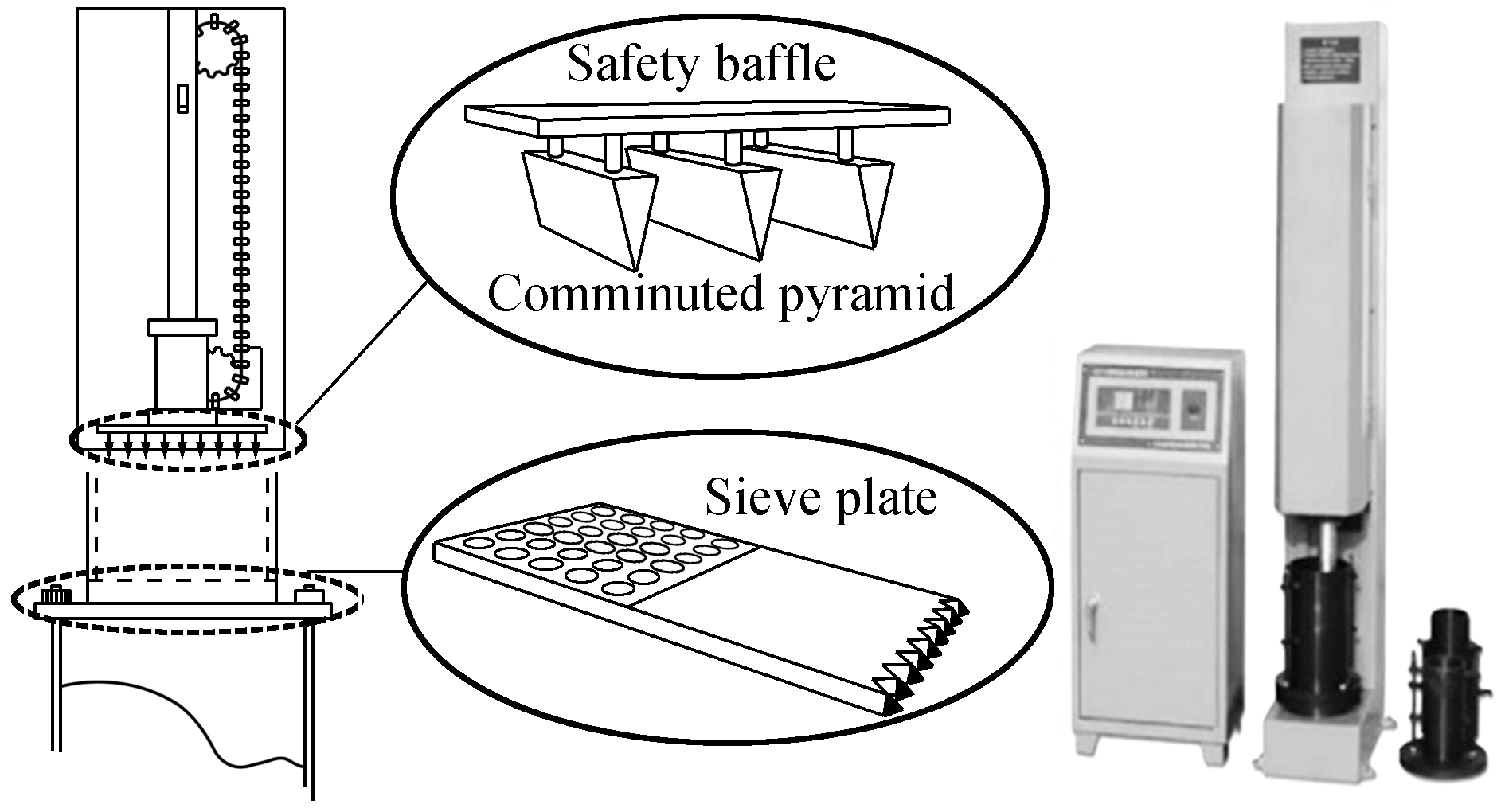
Fig.1 The self-developed glass crusher

Fig.2 The process of crushing and washing to prepare the glass aggregates
Tab.1 The comparison of apparent density between glass aggregates and mineral aggregates

Size/mmApparent density/ gcm-3 Glass aggregatesMineral aggregates4.752.4922.8332.362.4842.809
1.2 Surface treatment by using nano-Fe2O3
The main chemical components of waste glass are SiO2, Al2O3, CaO, MgO, and Na2O, and in the five basic oxides, the largest component is SiO2 which accounts for about 70%[23]. The content of SiO2 makes glass aggregates show hydrophilic, which will obviously affect the adhesion between the glass aggregates and asphalt[24-26]. Therefore, the adhesion loss for the hydrophilic property of acidic glass aggregates should be considered[27]. As for the special effects of nanometer particles, they can easily adhere to the glass aggregate surface so that the superficial physical and chemical conditions of glass aggregates are modified, which is beneficial for improving the adhesive strength between the asphalt and glass aggregates[28]. Nano-Fe2O3 is used as the glass superficial treating agent, and the pre-treatment result indicates that particles can adhere to the glass aggregate surface.
In this test,there are three types of nano-Fe2O3 powders with different particle sizes (50, 100 and 200 nm). According to the maximum particle size of aggregates, the water-immersion method is used for the particle size of aggregates less than or equal to 13.2 mm, and the water-boiling method is used for more than 13.2 mm. As the size of glass aggregates are 2.36 and 4.75 mm, the water immersion method is used to determine the optimum powder size and suspension concentration, according to the Chinese standard of experiments of the adhesion of asphalt and coarse aggregates (T0616—1993)[29]. According to the preliminary experiment and the comparison results, the anti-stripping effect of 50 nm Nano-Fe2O3 powder is the best.
To ascertain the optimum concentration of suspensions, five groups of nano-Fe2O3 suspensions of various mass fractions with 5% gradient are prepared. Similar for when determining the optimum size of the powder, the immersion test is carried out to determine the adhesion grade of each group of suspensions. The aggregates are dried and immersed in the heated asphalt, and then cooled, and boiled water is added. After soaking, the stripping degree is observed and the adhesion degree is evaluated. By the comparison analysis of the adhesion grade, it can be found that the adhesion grade of the glass aggregate treated by 10% mass fraction nano-Fe2O3 suspensions is level Ⅳ(the percentage of stripping area is less than 10%), which performs best in anti-stripping among all the groups. The adhesion grade of asphalt and aggregate is assessed by the percentage of stripping area according to the Chinese standard of experiments of the adhesion of asphalt and coarse aggregate (T0616—1993). The process of the cohesive test is shown in Fig.3.

Fig.3 The process of the cohesive test
From the above,the experimental and test results indicate that the optimum particle size of nano-Fe2O3 powder is 50 nm, and the optimum concentration of suspensions is 10% in mass fraction. Sieved glass aggregates are put into enamel plates and immersed with prepared nano-Fe2O3 suspensions for at least 3 d. During the soaking process, the glass aggregates are stirred at intervals to guarantee the immersion effect. The glass aggregates are treated with nano-Fe2O3 suspensions, and after thorough soaking, glass aggregates are dried in the oven under the temperature of 100 ℃.
2 Materials and Methods
2.1 Raw materials
In this study, raw materials include glass aggregates with surface treatment, SBS modified asphalt, mineral aggregates, and additive. The waste glass is flat glass from a glass processing plant, and it is prepared as glass aggregates by cleaning, crushing, sieving, and glass aggregate surface treating. The SBS modified asphalt is used, and all mineral aggregates are limestone and are mined from Jingyang, Shaanxi province, China. The general technical properties of SBS modified asphalt and mineral aggregates are tested. The penetration of unaged SBS modified asphalt was measured as 74 (0.1 mm) at 25 ℃ within 5 s by using a 100 g needle, the ductility was measured as 36.2 cm at 15 ℃ with the tensile rate of 5 cm/min, and the softening point was measured as 63.5 ℃. The thin film oven test was conducted at 163 ℃ within 5 h for aging the asphalt, and the penetration ratio of aged asphalt to the unaged one was determined as 75.7% while the ductility of aged asphalt was measured as 70.0 cm at 25 ℃ at the same rate. The results show that all the technical properties meet the requirements of the current specification[29-30]. In addition, hydrated lime is used as the additive.
2.2 Testing procedures
The specimens were tested based on Chinese specifications for the design of highway asphalt pavement[30]. The optimum contents of glass aggregates and asphalt were determined by a series of experiments, including the rutting test, three-point bending test, freeze-thaw splitting test, and skid resistance test. Six specimens were prepared for each test and their average values were used to ensure that the percent error of the specimens was relatively low.
The rutting test is used to evaluate the high temperature stability of asphalt mixtures. The size of specimens is 300 mm×300 mm×50 mm. The test wheel travels repeatedly along the same track on the specimen surface at a frequency of (42±1) times at 60 ℃, and the depth of rutting formed on the surface of the specimens under the repeated action of the test wheel is tested. The rutting resistance of asphalt mixtures is evaluated by the dynamic stability index, which is the travel times required to produce 1 mm rutting deformation.
The three-point bending test is a common method to evaluate the low temperature deformation ability of asphalt mixtures. With the test temperature (-10±0.5) ℃ and the loading rate of 50 mm/min, the concentrated load is applied to the middle span of asphalt mixtures trabecular specimens until fracture failure, the size of which is 35 mm×30 mm×250 mm, and the span is 200 mm. The flexural tensile strength, flexural strain and stiffness modulus are calculated.
Freeze-thaw splitting test simulates water erosion in the laboratory using a freeze-thaw cycle, and uses the change of splitting strength to characterize the moisture susceptibility of asphalt mixtures. The specimens size are φ101.6 mm×63.5 mm. The specimens are divided into two groups on average, six in each group. One group is immersed in water at 25 ℃ for 2 h before measuring its splitting strength. The other group is immersed in water at 25 ℃ for 2 h, and immersed in water at 0.09 MPa for 15 min, and then placed in the refrigerator at -18 ℃ for 16 h, then again immersed in the water bath at 60 ℃ for 24 h, and then immersed again at 25 ℃ for 2 h, finally testing its splitting strength. The ratio of residual strength TSR is calculated.
The friction coefficient of asphalt mixtures is measured by the British pendulum tester to characterize its skid resistance. The specimen sizes are 300 mm in length, 300 mm in width and 50 mm in thickness, and the test temperature is 20 ℃.
3 Glasphalt Mixture Design and Properties Eva-luation
3.1 Design of aggregate gradation and optimal asph-alt content
The aggregates’ gradation was designed based on the particle size, content of glass aggregates and mineral aggregates. Finally, the content of glass aggregates was determined to be 5%, 10%, 15%, 20%, 25%, according to the similar previous studies[31-32]. In this study, the gradation of AC-16 was adopted. The gradation composition and the gradation curve of glasphalt mixtures are shown in Tab.2 and Fig.4.
Tab.2 The gradation composition of glasphalt mixtures %

Sieve size/mmRemaining mass percentage on each sieve of different glass content5%10%15%20%25%165555513.211111111119.514141414144.7518.93.115.96.112.89.29.812.26.715.32.3612.11.910.13.98.25.86.27.84.39.71.189.59.59.59.59.50.6777770.3555550.15333330.0753.53.53.53.53.5<0.07566666
Note: The bold numbers are the glass content 2.36 and 4.75 mm, respectively.
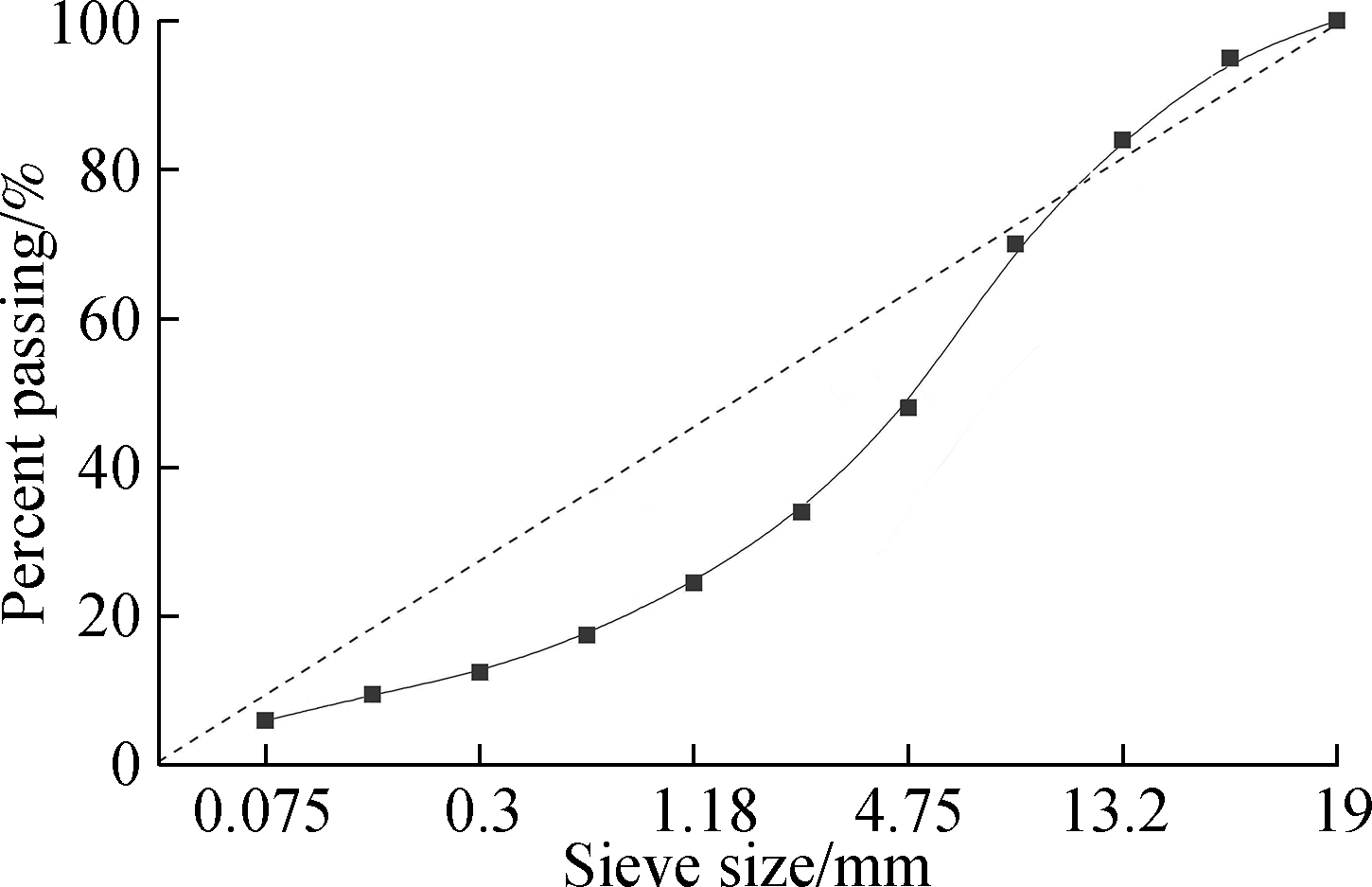
Fig.4 Gradation curve of glasphalt mixtures
As shown in Tab.2, the contents of glass aggregates are different at 2.36 and 4.75 mm. The proportion of mineral aggregates is very small when the total content of glass aggregates is 25%, according to the change trend in the ratio of 2.36 and 4.75 mm aggregates. The content of mineral aggregates at 2.36 and 4.75 mm is close to 0, if the content of glass aggregates exceeds 25%, and the greater glass aggregates content will threaten the strength and stability of mixtures. Therefore, the maximum content of the glass aggregates is determined to be 25%.
In this paper, the OAC of glasphalt mixtures is determined by the Marshall design method and the results are shown in Tab.3, and the OAC according to the physical and mechanical index with different contents of glass aggregates is shown in Tab.4.
From Tab.4, it can be seen that the optimum asphalt content shows a decreasing trend with the increase in glass content. With the addition of glass, the indices of mixture, including stability, tend to decrease gradually. It indicates that there is a negative effect on the asphalt mixtures. The content of 25% glass aggregates can meet the specifications.
3.2 Effects of glass aggregate contents on mixtures properties
High-temperature stability is used to characterize the ability of asphalt mixtures to resist permanent deformation with repeated load under high temperature conditions and maintain the flatness of the road surface. In this study, the rutting test is used to analyze high-temperature stability. Low-temperature crack resistance is used to characterize the stress relaxation and resistance to deformation of asphalt mixture. The three-point bending test is used to evaluate low-temperature crack resistance. Moisture susceptibility is used to characterize the ability to resist asphalt mixtures and aggregate stripping under water or water vapor without causing water damage. The freeze-thaw splitting test is used to evaluate the moisture susceptibility. In addition, the skid resistance test is carried out using a pendulum device to evaluate the skid resistance property.
The optimum contents of glass aggregates and asphalt are determined by a series of experiments, including the rutting test, three-point bending test, freeze-thaw splitting test, and skid resistance test. As shown in Fig.5, the results of the rutting test with different glass aggregate contents indicated that, with the increase in the glass aggregate content, the dynamic stability decreased. This is due to the poor adhesion between the glass aggregates and asphalt binder, and a thin layer of the asphalt film is coated on the surface of glass aggregates. The sliding property of this layer of the asphalt film at high temperature reduces the adhesion between glass aggregates and the asphalt binder, and with the increase in the glass aggregate content, the high temperature sliding phenomenon of the asphalt film becomes more obvious. In addition, the glass is brittle, and secondary crushing tends to occur during the rolling process, which changes the embedded structure inside the mixtures, and then reduces dynamic stability. When the content of glass aggregates exceeds 25%, the dynamic stability is less than 600 times/mm, which cannot meet the requirement of specification. Therefore, the maximum glass aggregates content should be less than 25%.
It can be seen from Fig.6(a) that the flexural tensile strength decreases with the increase in the glass aggregate content, since the adhesion between the glass aggregates and the asphalt binder is weak. Therefore, the addition of glass aggregates leads to the decrease in low-temperature strength. From Fig.6(b), the flexural strain increases first and then decreases, and reaches the maximum when the glass aggregate content is 15%. The reason is that when the glass aggregate content is small, the addition of glass aggregates increases the flexural deformation resist-ance of the mineral mixture, while the continuous increase of glass aggregate content will decrease the overall bonding ability of the mixture, so the flexural strain decreases. From Fig.6(c), the flexural stiffness modulus decreases first and then increases, and it reaches the minimum when the glass aggregate content is 15%. It can be seen from the above test results that the asphalt mixtures with 15% glass aggregate content can better meet the low temperature performance requirement.
Tab.3 Results of Marshall test at all levels with SBS modified asphalt

Glass addition/%Asphalt aggregate ratio/%Density/ gcm-3 Void age/%Stability/kNFlow value/0.1mmVMA/%VCA/%03.02.4628.29.2413.115.145.63.52.4826.89.5115.214.854.34.02.51159.6316.414.365.14.52.5253.710.0520.214.273.65.02.5382.58.4431.814.282.053.02.4777.18.0114.814.049.43.52.4836.28.3119.514.256.74.02.5074.69.4220.813.867.04.52.5173.59.1828.113.975.05.02.5152.98.5123.614.480.1103.02.4696.87.7017.313.750.33.52.4865.57.9521.213.659.64.02.4954.48.3523.313.767.54.52.5162.98.2225.913.477.95.02.5092.58.0528.514.081.9153.02.4626.57.9911.813.451.43.52.4765.38.0015.813.360.34.02.4993.77.4017.013.071.34.52.4973.16.5017.713.476.85.02.4882.86.1532.214.280.3203.02.4546.36.3814.513.152.33.52.4615.37.1918.413.360.14.02.4704.37.1021.113.468.14.52.4962.66.9920.912.980.05.02.4961.96.8823.213.385.7253.02.4495.96.2718.312.753.83.52.4604.87.1118.612.862.64.02.4713.76.9825.812.871.34.52.4802.66.7226.412.979.55.02.4981.36.5031.812.790.0
Note:VCA is the voids in coarse aggregate; VMA is the voids in mineral aggregate.
Tab.4 The OAC and the physical and mechanical index

Glass addition/%OAC/%Density/ gcm-3 Air void volume/%Marshall stability/kNFlow value/0.1mmVMA/%VCA/%04.52.5203.99.5222.414.472.654.52.5153.69.3828.114.074.5104.42.5103.38.5924.313.575.4154.42.4943.48.1222.913.575.0204.32.4873.27.2319.613.175.4254.32.4723.27.0124.613.075.2
As shown in Fig.7, with the increase in the glass aggregate content, the splitting strength of both unthawing specimens and thawing specimens decreases. Since glass is a hydrophilic material, the glass-asphalt interface is easily destroyed by water molecules, which can reduce the overall moisture susceptibility of the mixtures. The reduc-tion rate of thawing specimens is faster than that of the unthawing specimens. Accordingly, the splitting strength of glasphalt mixtures after a freeze-thaw cycle is higher than that without freeze-thaw, which is just the opposite of that of ordinary asphalt mixtures. It is due to the fact that under a freeze-thaw cycle, the internal interaction between aggregates and the asphalt binder is improved, so the water stability is enhanced. In this study, the glass aggregate is a silicate substance; iron oxide is alkaline; and the addition of nano-Fe2O3 changes the bonding characteristics of the interface between glass and asphalt. However, for more glass aggregates, due to the smooth surface of the glass and the limited ability to improve surface by nano-Fe2O3, the main role turns to the adhesion between the glass aggregates and asphalt binder. As shown in Fig.8, the value of TSR increases first and then decreases, and it reaches the maximum when the content of glass aggregates is 20%.
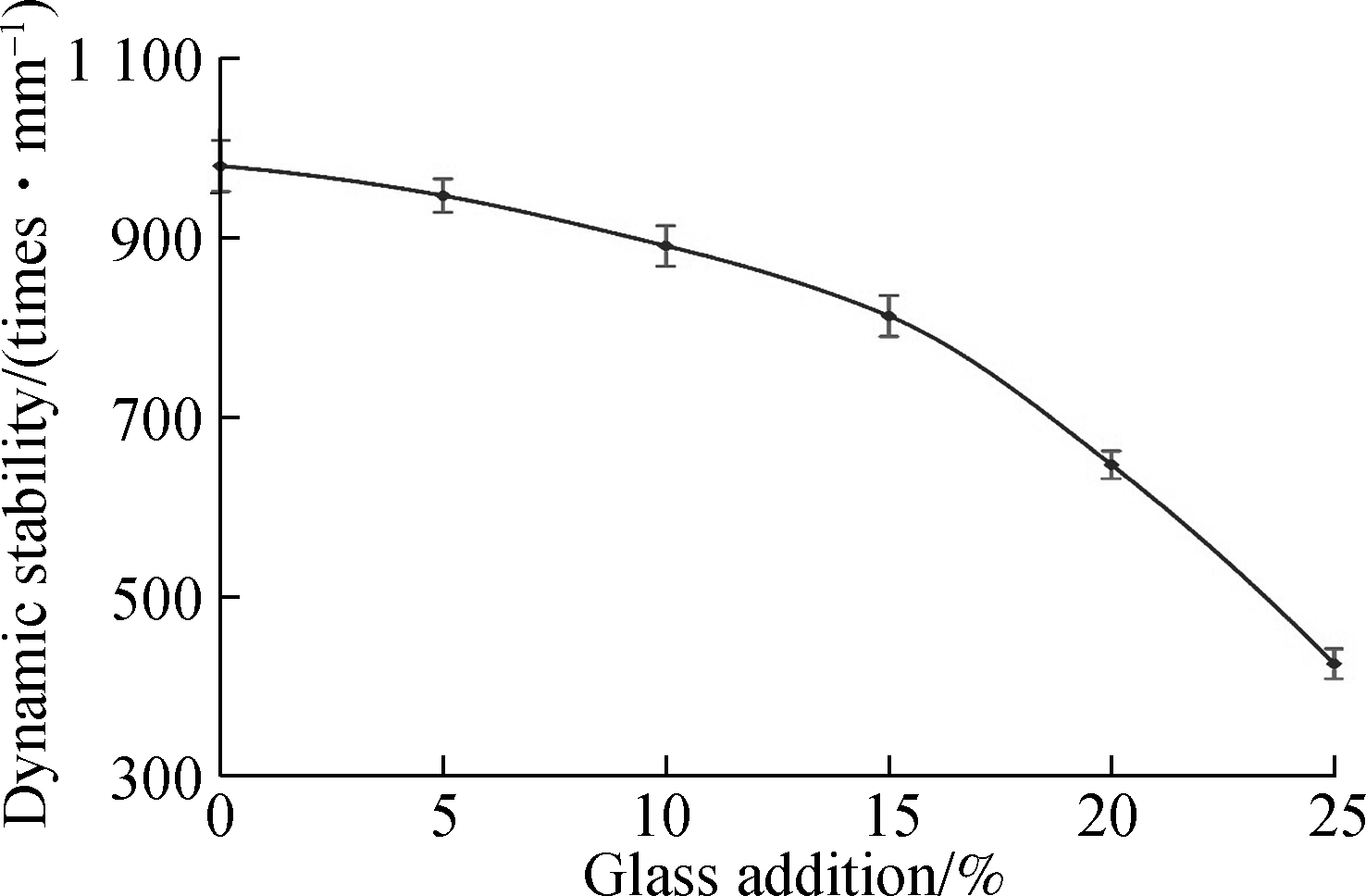
Fig.5 Dynamic stability under different glass additions
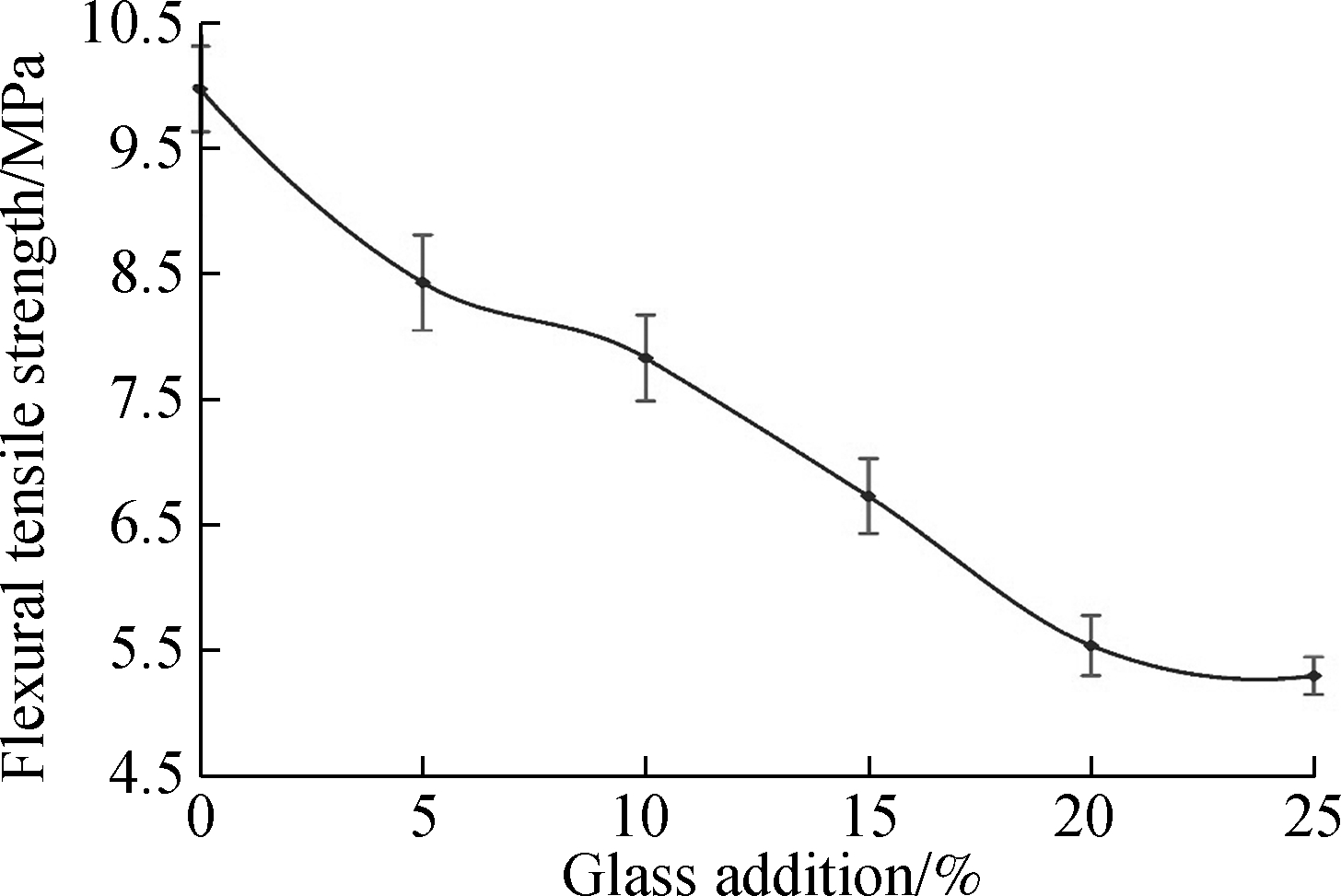
(a)

(b)
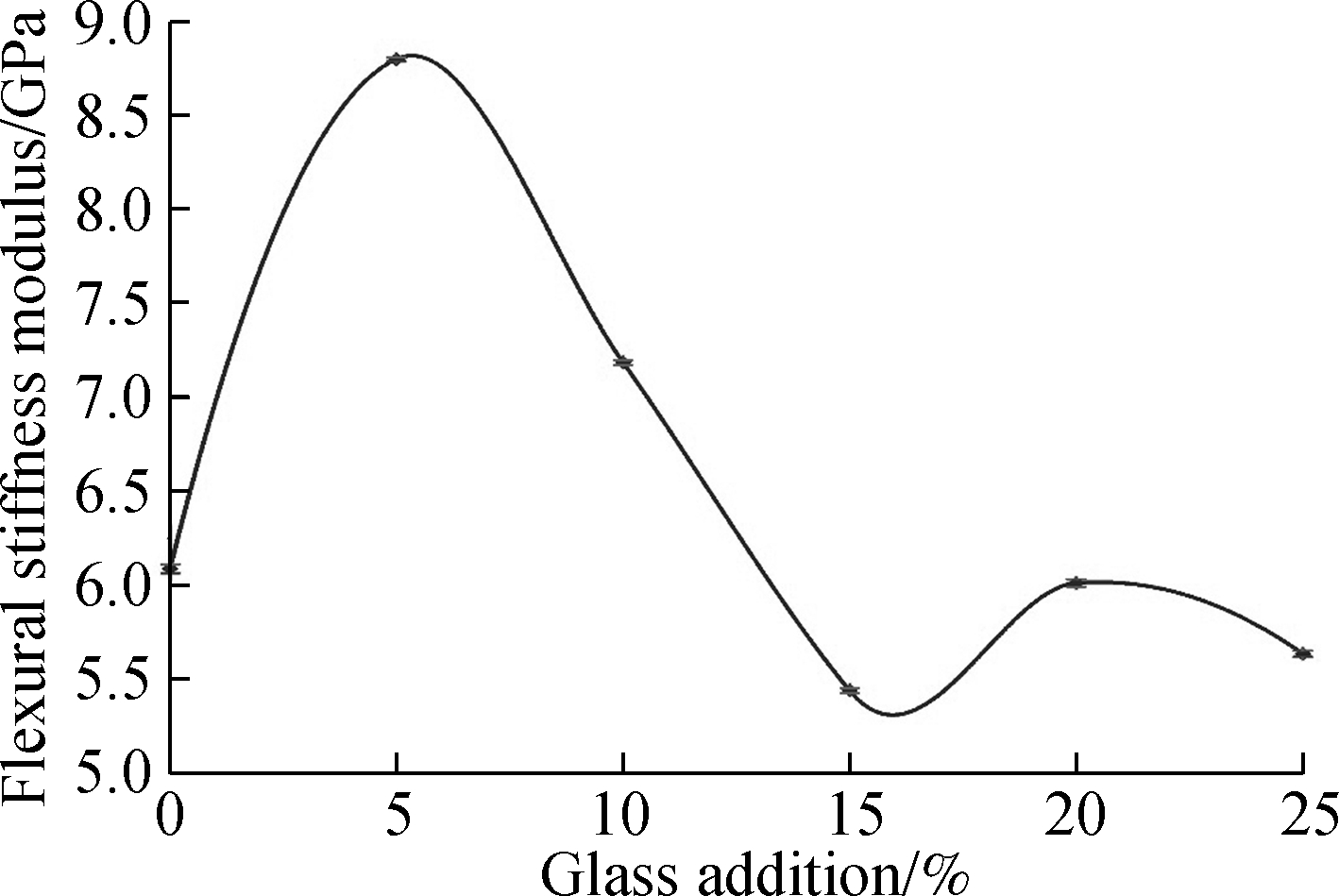
(c)Fig.6 Flexural tensile strength, maximum flexural strain and flexural stiffness modulus under different glass additions

Fig.7 Unthawing splitting strength and thawing splitting strength under different glass additions

Fig.8 TSR number under different glass additions
It can be seen from Fig.9 that with the increase in the glass aggregate content, the value of the British pendulum number (BPN) of glasphalt mixture increases first and then decreases. The trend is caused by the fact that when the glass aggregates content is less than 15%, the angularity of the glass aggregates leads to an improvement in the skid resistance property. When the glass aggregate content continues to increase, the smoothness of the glass aggregate surface dominates, and it causes a decrease in skid resistance property. Glasphalt mixtures with 15% glass aggregate content reaches the maximum BPN value.

Fig.9 British pendulum number under different glass additions
The optimum glass aggregate content is determined to be 15% by the above experimental results. When the content of glass aggregates is 15%, the dynamic stability is about 800 times/mm, which can meet the requirement of the highway, and the low-temperature stability and skid resistance property are optimum. Although the TSR reaches the maximum content of 20% glass aggregates, the 15% glass aggregates content was only below the maximum value. Therefore, considering the various factors, the optimum glass aggregates content was 15%, and according to Tab.4, the OAC is 4.4%.
4 Conclusions
1) The chemical composition and density of cullet are roughly equivalent to those of mineral aggregates. The range of particle sizes can be used for aggregates gradation design after crushing and sieving. In this paper, the particle size of the glass aggregates is selected to be 2.36 and 4.75 mm. The adhesion level is improved after the surface treatment of glass aggregates with 10% mass fraction nano-Fe2O3 suspensions.
2) The glasphalt mixtures are designed using the Marshall method. The determined OAC ranges from 4.3% to 4.5% for the mixtures with different glass aggregate contents, and OAC decreases with the increase in the glass aggregate content.
3) With the increase in the content of glass aggregates modified by nano-Fe2O3, the high temperature stability and moisture susceptibility decrease, the low temperature stability increases first and then decreases, and the anti-slip performance increases. The content of glass aggregates is recommended to be 15% according to the experimental results for technical properties.
However, some other technical properties such as fatigue and rheology properties are not proposed in this paper, but are considered in Refs.[33-34]. These technical properties will be explored in future scheduled study.
[1]Heriyanto, Pahlevani F, Sahajwalla V. From waste glass to building materials—An innovative sustainable solution for waste glass[J]. Journal of Cleaner Production, 2018, 191: 192-206. DOI:10.1016/j.jclepro.2018.04.214.
[2]Li Q, Chen X, Li G, et al. Fatigue resistance investigation of warm-mix recycled asphalt binder, mastic, and fine aggregate matrix[J]. Fatigue & Fracture of Engineering Materials & Structures, 2018, 41(2): 400-411. DOI:10.1111/ffe.12692.
[3]Paris J M,Roessler J G, Ferraro C C, et al. A review of waste products utilized as supplements to Portland cement in concrete[J]. Journal of Cleaner Production, 2016, 121: 1-18. DOI:10.1016/j.jclepro.2016.02.013.
[4]Ma T, Ding X H, Zhang D Y, et al. Experimental study of recycled asphalt concrete modified by high-modulus agent[J]. Construction and Building Materials, 2016, 128: 128-135. DOI:10.1016/j.conbuildmat.2016.10.078.
[5]Hakami B A, El-Sayed Sedek Abu Seif. Household solid waste composition and management in Jeddah City, Saudi Arabia: A planning model[J]. International Research Journal of Environment Sciences, 2015, 4(1): 1-10.
[6]Oliveira R, deBrito J, Veiga R. Reduction of the cement content in rendering mortars with fine glass aggregates[J]. Journal of Cleaner Production, 2015, 95: 75-88. DOI:10.1016/j.jclepro.2015.02.049.
[7]Kazmi S M S, Abbas S, Nehdi M L, et al. Feasibility of using waste glass sludge in production of ecofriendly clay bricks[J]. Journal of Materials in Civil Engineering, 2017, 29(8): 04017056. DOI:10.1061/(asce)mt.1943-5533.0001928.
[8]Kim K, Kim K. Valuable recycling of waste glass generated from the liquid crystal display panel industry[J].Journal of Cleaner Production, 2018, 174: 191-198. DOI:10.1016/j.jclepro.2017.10.326.
[9]Poulikakos L D, Papadaskalopoulou C, Hofko B, et al. Harvesting the unexplored potential of European waste materials for road construction[J]. Resources, Conservation and Recycling, 2017, 116: 32-44. DOI:10.1016/j.resconrec.2016.09.008.
[10]Antunes V, Freire A C, Quaresma L, et al. Evaluation of waste materials as alternative sources of filler in asphalt mixtures[J]. Materials and Structures, 2017, 50(6): 254. DOI:10.1617/s11527-017-1126-3.
[11]Lee H,Hanif A, Usman M, et al. Performance evaluation of concrete incorporating glass powder and glass sludge wastes as supplementary cementing material[J]. Journal of Cleaner Production, 2018, 170: 683-693. DOI:10.1016/j.jclepro.2017.09.133.
[12]Lu J X,Poon C S. Recycling of waste glass in construction materials[M]// New Trends in Eco-Efficient and Recycled Concrete. Elsevier, 2019: 153-167. DOI:10.1016/b978-0-08-102480-5.00006-3
[13]Gupta J, Sharma V,Mathur D, et al. To study effects on the strength of concrete after partially replacing fine aggregates by waste glass bottle in M40 concrete mix[J]. Journal of Structural Engineering and Management, 2018, 5(1): 39-48.
[14]Lu J X,Poon C S. Use of waste glass in alkali activated cement mortar[J]. Construction and Building Materials, 2018, 160: 399-407. DOI:10.1016/j.conbuildmat.2017.11.080.
[15]Arabani M, Tahami S A, Taghipoor M. Laboratory investigation of hot mix asphalt containing waste materials[J]. Road Materials and Pavement Design, 2017, 18(3): 713-729. DOI:10.1080/14680629.2016.1189349.
[16]Sanij H K, Meybodi P A, Hormozaky M A, et al. Evaluation of performance and moisture sensitivity of glass-containing warm mix asphalt modified with zycothermTM as an anti-stripping additive[J]. Construction and Building Materials, 2019, 197: 185-194. DOI:10.1016/j.conbuildmat.2018.11.190.
[17]Qiu J, Ma F, Zhu C Z, et al. A waste glass crushing device: China patent, 201621387030.3[P]. 2017-07-21.(in Chinese)
[18]Bignozzi M C, Saccani A, Barbieri L, et al. Glass waste as supplementary cementing materials: The effects of glass chemical composition[J]. Cement and Concrete Composites, 2015, 55: 45-52. DOI:10.1016/j.cemconcomp.2014.07.020.
[19]Avila-López U, Almanza-Robles J M, Escalante-García J I. Investigation of novel waste glass and limestone binders using statistical methods[J]. Construction and Building Materials, 2015, 82: 296-303. DOI:10.1016/j.conbuildmat.2015.02.085.
[20]Mardani-Aghabaglou A, Tuyan M, Ramyar K. Mechanical and durability performance of concrete incorporating fine recycled concrete and glass aggregates[J]. Materials and Structures, 2015, 48(8): 2629-2640. DOI:10.1617/s11527-014-0342-3.
[21]Srivastava I, Gupta D, Sehmi S S, et al. Partial replacement of fine aggregates with waste glass[J]. International Journal of Advance Research, Ideas and Innovations in Technology, 2017, 3(4): 746-749.
[22]Zakaria N M, Hassan M K, Ibrahim A N H, et al. The use of mixed waste recycled plastic and glass as an aggregate replacement in asphalt mixtures[J]. Jurnal Teknologi, 2018, 80(1): 79-88.
[23]Chen Z, Li J S,Poon C S. Combined use of sewage sludge ash and recycled glass cullet for the production of concrete blocks[J]. Journal of Cleaner Production, 2018, 171: 1447-1459. DOI:10.1016/j.jclepro.2017.10.140.
[24]Zhang J P, Liu G Q, Zhu C Z, et al. Evaluation indices of asphalt-filler interaction ability and the filler critical volume fraction based on the complex modulus[J]. Road Materials and Pavement Design, 2017, 18(6): 1338-1352. DOI:10.1080/14680629.2016.1218789.
[25]Zhang J P, Liu G Q, Zhu C Z, et al. Evaluation indices of asphalt-filler interaction ability and the filler critical volume fraction based on the complex modulus[J]. Road Materials and Pavement Design, 2017, 18(6): 1338-1352. DOI:10.1080/14680629.2016.1218789.
[26]Zhang J P, Fan Z P, Hu D L, et al. Evaluation of asphalt-aggregate interaction based on the rheological properties[J]. International Journal of Pavement Engineering, 2018, 19(7): 586-592. DOI:10.1080/10298436.2016.1199868.
[27]Huang X M, Wu S P, Zhao Y L. Asphalt and asphalt mixture[M]. Nanjing: Southeast University Press, 2002: 94-98.(in Chinese)
[28]Mukhopadhyay A K. Next-generation nano-based concrete construction products: A review [M]//Nanotechnology in Civil Infrastructure. Berlin: Springer, 2011: 207-223. DOI:10.1007/978-3-642-16657-0_7.
[29]Ministry of Transport of the People’s Republic of China. JTG-E20—2011 Test procedures for asphalt and asphalt mixture in highway engineering[S]. Beijing: China Communications Press, 2011. (in Chinese)
[30]Ministry of Transport of the People’s Republic of China. JTGD50—2017 Specifications for design of highway asphalt pavement[S]. Beijing: China Communications Press, 2017. (in Chinese)
[31]Tahmoorian F, Samali B, Yeaman J, et al. The use of glass to optimize bitumen absorption of hot mix asphalt containing recycled construction aggregates[J]. Materials, 2018, 11(7): 1053. DOI:10.3390/ma11071053.
[32]Mohammadreza T A, Taherabadi E, Roustaei M, et al. Modification of silty clay strength in cold region’s pavement using glass residue[J]. Cold Regions Science and Technology, 2018, 154: 111-119.DOI:10.1016/j.coldregions.2018.06.005.
[33]Huang T,Zheng J L, Lü S T, et al. Failure criterion of an asphalt mixture under three-dimensional stress state[J]. Construction and Building Materials, 2018, 170: 708-715.DOI:10.1016/j.conbuildmat.2018.03.081.
[34]Geng L, Ma T, Zhang J, et al. Research on performance of a dense graded ultra-thin wearing course mixture[J]. Applied Sciences, 2017, 7(8): 800-1-800-16. DOI:10.3390/app7080800.